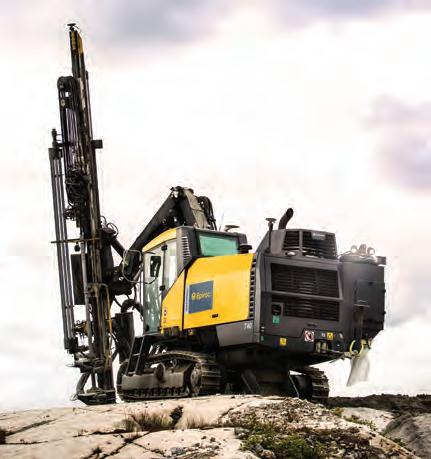
4 minute read
SMARTER DRILLING AUTOMATION THE KEY
INDUSTRY LEADERS CRAIG MARSH
Epiroc
SMARTER DRILLING PRACTICES, AUTOMATION KEY TO BLASTING
Craig Marsh is the Business Line Manager for Epiroc’s Surface Division. He talks about ongoing innovation and automation in Epiroc’s fleet of smart surface drill rigs which are replacing more manual-style rigs.
The SmartROC T40 is counted in the 93 per cent of sales of Epiroc drill rigs to the Australian quarrying and mining industries.
How has Epiroc’s surface drill division performed in the global pandemic? In general, the industry itself has done well. Quarrying has remained stable. We haven’t lost anything, and that’s a credit to the industry.

Has the pandemic changed the way Epiroc does business with Australian quarries? We had people in the west and the east, so we could cover our client base. Our business consists of technical support, sales and management. Our technical support hasn’t changed much, and during the pandemic, we had to move people around to problem solve. There was less impact on the marketing team because a lot of the communication was virtual.
When the pandemic changes, my team and I will go back to face to face meetings with customers. Technology has helped us through the pandemic but we’ll return mostly to what we were doing before.
What are some of the common challenges quarries are experiencing in the drill and blast process? On the drilling side, it’s skilled people. As rigs move into automation, it’s to train people how to use them more efficiently and understand the need to move to automation. Major quarry owners and Tier 1 contractors are driving that.
How can Epiroc help address these challenges? We can demonstrate the advantages of using our rigs’ single hole autonomy. That takes out some of the skill set requirement from a drilling perspective.
We also promote the digital information the rig collects, how that benefits customers and helps them make decisions. A lot is being driven in the data area, eg checking on the rig for faults or alarms via mobile phone.
If the rig is connected to 3G/4G, problems can be addressed in real time. There are different layers of platforms to how much information you get, when you get it and what you do with it. That’s entirely up to the customer.
What are Epiroc’s most popular drill rigs in the quarrying industry? About 93 per cent of the rigs we sell to the quarrying and mining markets are SmartROCs. We sell the PowerROC rig but many small contractors are migrating to the SmartROC rigs because the quarry owners are demanding that technology for their jobs.
More SmartROC C50s are also operating in quarries that require larger hole sizes than a traditional quarry, eg 115mm.
The SmartROCs are simpler to operate because they have semi-autonomous drilling. There’s the fuel burn ratio, the amount of fuel burned in metres used. These are some of the lowest fuel burn rigs on the market.
We’ve slashed the number of hydraulic hoses on the rig by 50 per cent, reducing the amount of oil circulation. From our data collection, we can design patterns remotely and send them wirelessly to the rig. The ground in front of the operator can be bare but the screen will specify where the ground should be drilled, what depths should be drilled, at what angles they should be drilled, and the rigs will automatically drill. The rig will know how far to drill and how far to stop.
What programs does Epiroc offer beyond installation of plant and equipment? We’re trying to integrate more data processing and reporting. We have different layers of automation, communication and digitalisation – Surface Manager, Rock Manager and Surface Manager report data from the rig and you can send information back to it. We’re pushing for single hole automation.
What innovations are your products adopting to save time, costs and energy? We’re constantly innovating on fuel burn and oil. In 2007-08, our rigs were burning up to 24 litres of fuel per hour, now it’s 14 litres per hour. A hydraulic oil tank back then held 400 litres, now it’s 100 litres. Hosing has dropped by 50 per cent, electrical cables by 60 per cent.
We’re talking with quarries about BenchRemote, where if a quarry has three rigs, it can run a third remotely. To be effective, all three rigs should be operating in the one place. As rigs move around sites, it’s more difficult for customers to justify the investment.
What will the quarry industry’s major challenges be in the next three years? Access to labour and different emissions regulations will be a focus. Some quarries may have to consider how to reach zero emissions by 2030. That work has to start now.
Larger quarry owners will set the standard and that will filter down to smaller quarries and contractors.
How can Epiroc assist the extractive industries with meeting these future challenges? The equipment the majors use is available for smaller contractors, along with packages to support them with technology advances. We need to assure the industry of our expertise to support them through that change.
For more information about Epiroc’s products and services, visit epiroc.com/en-au










